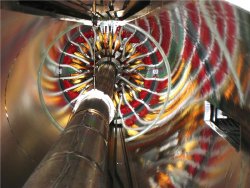Mar 3 2010
CERN has been able to take the first measurements of collisions between particles with the highest energy ever generated. These collisions were performed at CERN's new LHC accelerator and recorded with the CMS Experiment, which involved a key component (the barrel pixel detector) contributed by the Paul Scherrer Institute PSI in collaboration with Swiss Universities.
The first LHC operation in December 2009 has now resulted in a first particle physics publication of the CMS experiment. This is after a remarkably short time, given the complexity and the size of this gigantic experiment constructed and operated by more than 3000 physicists and engineers from close to 40 countries.
 The pixel detector at the centre of the CMS after the installation stage at CERN (Credit: H.R. Bramaz/PSI)
The pixel detector at the centre of the CMS after the installation stage at CERN (Credit: H.R. Bramaz/PSI)
The new ring accelerator at CERN, the Large Hadron Collider (LHC) resumed operation end of November 2009 after the major incident, which caused a delay of more than a year. However, now it is working so well that millions of collisions between protons from the two different beams have been induced. Each head-on collision between a pair of protons creates new elementary particles, which fly away from each other like flinders of an explosion. The pixel detector developed by the Paul Scherrer Institute is located just a few centimetres away from the collision site, and registers the particles' flight direction from this ring-side seat. Three layers of pixel detectors are positioned around the beam containing the colliding protons, like the layers of a vast Russian doll; the innermost of the three detectors is located just 4cm from the proton collision site. It has to operate with great precision to deliver three-dimensional images of the particles' flight paths. In just a few hours, researchers from the participating institutes were able to collect enough data to take an initial particle-physics recording. This confirmed the predictions made in advance by computer simulation, and led to the first scientific article based on this experiment, which was accepted for publication in record time. At last, scientists can be absolutely certain that their detector is working as required.
"Crazy project"
The development of this pixel detector alone has involved 15 years of work by dozens of scientists - from other institutions as well as PSI. For example, the lightweight carbon fibre mechanics was supplied by the University of Zurich. ETH Zurich made vital contributions to the design of the overall electronic system. Key components, such as the connection technology, sensor and readout chip, were developed at PSI where the detector was also assembled.
"In the beginning the project seemed completely crazy" said Project Manager Roland Horisberger. An accurate, powerful detector was required which exceeded the specifications of the technologies available at that time This meant that every aspect had to be developed from scratch; there was nothing but an ambitious vision, and nobody knew if this could become a reality. By now, however, it has long since proved its viability. Detectors based on the technology developed for this project have already been in use for some years at the Swiss Light Source SLS, one of PSI's large-scale facilities. In the meanwhile the concept of pixel detectors stepped out of the institute. The Dectris company, a PSI spinoff, manufactures and sells these detectors extremely successfully world-wide. They are still without competitor in this market.
Gigantic equipment in the search for miniscule particles
What is the reason for the enormous effort? The pixel detector developed by PSI's scientists is placed in the centre of the 22-metre long CMS (Compact Muon Solenoid) detector at CERN. It weighs 12,500 Tonnes and is one of the largest measuring instruments ever built. CMS is one of four experiments at the enormous LHC (Large Hadron Collider) accelerator at CERN, which physicists hope to use to discover more about the solution to the great mysteries of matter.
For example, scientists hope that they will be able to use these particle collisions to prove the existence of the legendary Higgs particle, the last missing (but fundamental) component in the standard model of elementary particle physics. Once they find this particle, they will be able to explain how elementary particles achieve their mass.
Particle physicists also want to find out whether so-called super-symmetrical (SUSY) particles exist. These could be used to explain the dark matter in space, which continues to puzzle physicists. One theory, which is still speculative, suggests that it might be made up of super-symmetrical particles - but nobody has seen them, yet. Nevertheless, if they did exist, they would decay into a large number of subatomic particles called B mesons. The easiest way to recognise these particles is by their habit of flying a few millimetres away from the point at which they are produced, before they themselves decay into lighter elementary particles. If these decay locations could be measured accurately, this would help to filter out the few spectacular results from the billions upon billions of particle collisions taking place in the CMS. Finding and investigating B mesons represents one of the main activities of the PSI's particle physicists.
Tracking down new laws of nature
Roland Horisberger explains: "If the particle energy crosses a critical, still unknown threshold, we may discover new laws of nature. Even those physical laws that we find very familiar today are only valid up to a certain point".
The measurements quoted in the publication were obtained at 0.9 to 2.36 teraelectron volts (TeV). This alone is a world record. However, the aim of the physicists is to achieve collisions at 14TeV. These would represent conditions as present shortly after the Big Bang. By that stage at the latest, the Higgs or super-symmetrical particles should have appeared - if they exist at all.